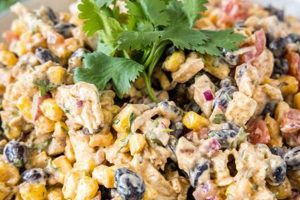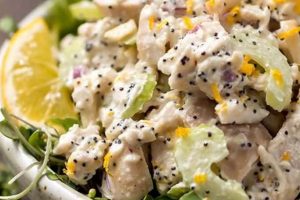Transforming already prepared chicken salad into new and exciting dishes presents an opportunity to minimize food waste and maximize culinary creativity. This involves utilizing existing chicken salad as a core ingredient in a variety of meals, from simple sandwiches and wraps to more complex casseroles, stuffed vegetables, or even as a topping for salads and pizzas.
Repurposing prepared foods offers significant advantages. It saves time and resources by reducing the need to prepare entirely new meals. Furthermore, it provides a practical solution for using surplus food, contributing to a more sustainable approach to cooking and minimizing waste. Historically, resourceful cooks have employed such strategies to stretch ingredients and create diverse meals, demonstrating a long-standing tradition of culinary ingenuity and thriftiness.
The following sections explore a diverse range of culinary applications for pre-made chicken salad, providing detailed instructions and creative suggestions for incorporating it into delicious and innovative dishes.
Tips for Utilizing Prepared Chicken Salad
Maximizing the versatility of existing chicken salad allows for creative meal planning and reduces food waste. These tips offer practical guidance on transforming leftover chicken salad into appealing and flavorful dishes.
Tip 1: Elevate Sandwiches and Wraps: Move beyond basic sandwiches by incorporating interesting textures and flavors. Consider using croissant rolls, focaccia, or tortillas. Add crisp lettuce, sliced tomatoes, or roasted red peppers for added flavor and visual appeal.
Tip 2: Create Satisfying Salads: Chicken salad can be a protein-rich addition to green salads. Combine it with mixed greens, nuts, dried cranberries, and a light vinaigrette for a complete meal.
Tip 3: Explore Stuffed Vegetables: Hollowed-out tomatoes, bell peppers, or avocados provide attractive vessels for chicken salad. Baking or grilling these stuffed vegetables adds another layer of flavor.
Tip 4: Enhance Baked Potatoes: Top baked potatoes with chicken salad for a quick and flavorful meal. Additions like shredded cheese, chives, or bacon bits can further enhance the dish.
Tip 5: Transform into a Dip: Serve chicken salad as a dip with crackers, pita bread, or vegetable sticks for a simple appetizer or snack. Consider adding cream cheese or sour cream for a creamier consistency.
Tip 6: Create a Savory Tart or Quiche: Use chicken salad as a filling for a tart or quiche. Combine it with a custard base and bake in a pastry crust for a satisfying and elegant dish.
Tip 7: Incorporate into Pasta Salad: Add chicken salad to cooked pasta along with chopped vegetables and a creamy dressing for a flavorful pasta salad.
Employing these strategies not only reduces food waste but also introduces variety and flavor into meal planning. These adaptable techniques offer a range of possibilities for transforming leftover chicken salad into enjoyable and convenient meals.
By exploring these options, one can discover a multitude of ways to enjoy chicken salad beyond its traditional applications.
1. Resourcefulness
Resourcefulness plays a crucial role in the context of utilizing leftover chicken salad. It represents an approach to cooking that prioritizes minimizing waste and maximizing the value of existing ingredients. This mindset encourages creative thinking and culinary innovation, transforming what might be considered leftovers into entirely new and appealing dishes. Resourcefulness goes beyond simply avoiding food waste; it fosters a more sustainable and economical approach to meal preparation. For instance, instead of discarding leftover chicken salad, a resourceful cook might incorporate it into a frittata, thereby creating a new breakfast or brunch dish while simultaneously reducing food waste. This approach also extends to using pantry staples and readily available ingredients to complement the existing chicken salad, further maximizing resource utilization.
Practical applications of resourcefulness in this context are numerous. Leftover chicken salad can be used as a filling for stuffed vegetables, a topping for baked potatoes, or an ingredient in a quick pasta salad. Such applications demonstrate how a simple shift in perspective can transform a surplus ingredient into a key component of diverse and satisfying meals. This resourceful approach not only benefits individual households by reducing food costs and minimizing waste but also contributes to a broader culture of sustainability by promoting efficient resource management.
In summary, resourcefulness is integral to the concept of leftover chicken salad recipes. It empowers cooks to view leftover ingredients not as remnants but as opportunities for culinary creativity. This approach, rooted in practicality and sustainability, transforms potential food waste into delicious and innovative meals, contributing to both individual and collective well-being. Addressing the challenge of food waste through resourceful cooking practices like these is a significant step towards a more sustainable food culture.
2. Flavor Combinations
Flavor combinations are essential to the success of recipes utilizing leftover chicken salad. The existing flavor profile of the chicken salad, determined by ingredients such as mayonnaise, celery, onion, and seasonings, serves as a foundation upon which new flavor dimensions can be built. Understanding this existing flavor profile allows for strategic ingredient pairings that complement and enhance the overall dish. For example, a chicken salad with a pronounced dill flavor might pair well with lemon and capers, while a sweeter chicken salad might benefit from the addition of curry powder and dried apricots.
Successful flavor combinations often rely on principles of balance and contrast. The richness of the mayonnaise in chicken salad can be balanced by acidic ingredients like vinegar or citrus juice, while the creamy texture can be contrasted with crunchy elements like nuts, seeds, or chopped vegetables. The existing sweetness, saltiness, or spiciness of the chicken salad should be considered when selecting additional ingredients. A chicken salad that is already quite savory might not require additional salt, whereas a blander chicken salad could benefit from the addition of bolder spices or herbs. Incorporating varied textures and flavors not only elevates the taste of the dish but also adds visual appeal, creating a more enjoyable dining experience. Consider, for instance, the textural contrast between creamy chicken salad and crispy lettuce in a wrap, or the interplay of sweet and savory flavors in a chicken salad melt with cranberry sauce and cheddar cheese.
In conclusion, carefully considered flavor combinations are crucial for transforming leftover chicken salad into appetizing and innovative dishes. By understanding the existing flavor profile of the chicken salad and employing principles of balance and contrast, cooks can create meals that are not only delicious but also demonstrate resourcefulness and culinary expertise. The practical application of these principles allows for a diverse range of dishes, from simple sandwiches and salads to more complex casseroles and baked goods, all while minimizing food waste and maximizing flavor.
3. Texture Variations
Texture variations play a significant role in elevating leftover chicken salad recipes beyond basic repurposing. The inherent creaminess of chicken salad, primarily derived from mayonnaise or other binding agents, benefits from the introduction of contrasting textures. This interplay of textures creates a more dynamic and satisfying sensory experience, preventing the dish from feeling monotonous. Adding crunchy elements, such as chopped celery, water chestnuts, or toasted nuts, provides a counterpoint to the soft texture of the chicken and the creamy base. Incorporating crisp ingredients like lettuce, shredded carrots, or sliced cucumbers within a sandwich or wrap further enhances this textural contrast.
Consider the example of a chicken salad croissant sandwich. The flaky, buttery layers of the croissant provide a textural contrast to the creamy chicken salad filling. Adding toasted almonds or chopped walnuts to the chicken salad itself further amplifies this effect, creating a multi-dimensional textural experience. Similarly, serving chicken salad over a bed of mixed greens with a variety of textures, from delicate spinach to crunchy romaine lettuce, introduces another layer of textural complexity. Even a simple addition like croutons or crispy fried onions can significantly enhance the overall textural profile of a dish featuring leftover chicken salad.
Understanding the importance of textural variation allows for strategic ingredient selection and preparation techniques. Dicing vegetables finely versus coarsely, toasting nuts before adding them to the salad, or choosing a bread with a pronounced crust all contribute to the final textural composition of the dish. By thoughtfully incorporating contrasting textures, cooks can transform leftover chicken salad from a simple convenience food into a more sophisticated and enjoyable culinary creation. This attention to texture not only elevates the sensory experience but also demonstrates a deeper understanding of culinary principles, resulting in more satisfying and well-rounded meals.
4. Presentation
Presentation significantly impacts the perceived value and enjoyment of dishes incorporating leftover chicken salad. While the inherent flavor and quality of the ingredients remain important, thoughtful presentation elevates the dining experience. A simple scoop of chicken salad on a plate appears less appealing than a carefully constructed sandwich on attractive bread or a vibrant salad with artfully arranged components. This visual appeal stimulates appetite and enhances the overall perception of the meal. For instance, serving chicken salad in hollowed-out tomatoes or avocado halves creates a visually appealing presentation compared to simply placing it on a plate. Similarly, using a cookie cutter to shape chicken salad sandwiches adds a touch of whimsy and elevates the perceived value of the dish.
Practical applications of presentation principles are numerous. Garnishing a chicken salad sandwich with fresh herbs or a sprinkle of paprika adds visual interest. Arranging chicken salad on a bed of lettuce with colorful vegetables creates a more appealing salad. Using attractive serving dishes and appropriate cutlery further enhances the dining experience. Even simple touches, such as using toothpicks with decorative flags or arranging crackers around a bowl of chicken salad dip, demonstrate attention to detail and elevate the perceived quality of the dish. These presentation techniques do not necessarily require additional time or resources but demonstrate an understanding of the importance of visual appeal in enhancing culinary enjoyment. Consider the difference between serving chicken salad directly from its container versus transferring it to a decorative bowl and garnishing it with chopped chives. The latter presentation immediately elevates the dish, making it more enticing and appetizing.
Effective presentation is integral to maximizing the enjoyment of leftover chicken salad recipes. It transforms a simple repurposing effort into a more considered and appealing culinary experience. By understanding the impact of visual appeal on appetite and perception, cooks can elevate even the simplest dishes, fostering a greater appreciation for resourcefulness and culinary creativity. This attention to detail not only enhances individual dining experiences but also contributes to a broader culture of appreciating food as not just sustenance, but as a source of pleasure and aesthetic enjoyment.
5. Nutritional Value
Nutritional value represents a crucial consideration when evaluating leftover chicken salad recipes. Maintaining a balanced diet and maximizing nutrient intake are essential for overall health and well-being. Understanding the nutritional composition of chicken salad, and how it can be enhanced or diminished through recipe modifications, allows for informed choices that support individual dietary needs and goals. This involves considering the protein, fat, carbohydrate, vitamin, and mineral content of the chicken salad and any additional ingredients incorporated into new dishes.
- Macronutrient Content
Chicken salad typically provides a significant source of protein, derived from the chicken itself. However, the fat content can vary depending on the type and amount of mayonnaise or other binding agents used. Incorporating additional ingredients, such as nuts, seeds, or avocados, can further influence the macronutrient profile. Understanding this balance is essential for managing caloric intake and ensuring adequate protein consumption, particularly for individuals with specific dietary requirements or fitness goals.
- Micronutrient Contributions
Chicken provides essential micronutrients like niacin, selenium, and vitamin B6. The addition of vegetables to the chicken salad, or incorporating it into dishes with other nutrient-rich ingredients, can further enhance the micronutrient profile. For example, adding chopped celery or bell peppers to the salad contributes vitamins and fiber. Using the chicken salad as a filling for stuffed bell peppers increases the overall vegetable intake. These considerations become particularly relevant when repurposing chicken salad for meals intended to provide a complete nutritional profile.
- Sodium Content
Processed chicken and certain seasonings can contribute to a relatively high sodium content in some chicken salads. Being mindful of this is particularly important for individuals managing sodium intake for health reasons. Recipe modifications, such as using lower-sodium chicken or incorporating fresh herbs instead of salty seasonings, can mitigate this concern. Choosing lower-sodium breads, crackers, or other accompanying ingredients also contributes to overall sodium management.
- Fiber Enhancement
Chicken salad itself is not typically a significant source of dietary fiber. However, incorporating fiber-rich ingredients into recipes using leftover chicken salad can enhance its nutritional value. Adding chopped vegetables, such as carrots, celery, or bell peppers, directly to the chicken salad increases its fiber content. Using the chicken salad in a sandwich on whole-wheat bread or as a filling for lettuce wraps provides additional fiber. These considerations are important for promoting digestive health and overall well-being.
By understanding these nutritional facets, individuals can make informed choices about incorporating leftover chicken salad into their diets. Balancing macronutrients, maximizing micronutrient intake, managing sodium content, and enhancing fiber intake contribute to a more holistic approach to nutrition. This awareness allows for the creation of dishes that are not only delicious and convenient but also support individual health goals and dietary needs, further demonstrating the versatility and value of resourceful cooking practices.
6. Ease of Preparation
Ease of preparation is a key factor influencing the adoption and frequency of leftover chicken salad recipes. The inherent convenience of using pre-made chicken salad as a base ingredient lends itself to quick and easy meal solutions. This aspect is particularly relevant in today’s fast-paced world, where time constraints often dictate meal choices. The following facets explore the various components contributing to the ease of preparation associated with these recipes.
- Minimal Cooking Time
Leftover chicken salad, by definition, requires no additional cooking of the core ingredient. This eliminates a significant time commitment typically associated with meal preparation. Recipes utilizing leftover chicken salad often involve simple assembly or minimal cooking steps, such as combining the chicken salad with other pre-cooked or ready-to-eat ingredients. This allows for rapid meal creation, making it a practical choice for busy weeknights or when time is limited. Examples include creating a quick chicken salad sandwich, topping a baked potato with chicken salad, or mixing it into a pre-made salad. These minimal cooking times greatly reduce the overall effort required for meal preparation.
- Simple Ingredient Lists
Recipes utilizing leftover chicken salad often require few additional ingredients, many of which are commonly found in pantries or refrigerators. This simplifies the shopping process and reduces the need for specialized ingredients. Furthermore, it contributes to the overall affordability and accessibility of these recipes. For instance, a chicken salad sandwich might only require bread, lettuce, and tomato in addition to the pre-made chicken salad. This simplicity makes these recipes appealing to both experienced cooks and those with limited culinary skills or time constraints.
- Adaptability and Versatility
Leftover chicken salad possesses a remarkable adaptability, lending itself to a wide range of applications. It can be incorporated into sandwiches, wraps, salads, stuffed vegetables, or even used as a pizza topping. This versatility simplifies meal planning and allows for creative variations based on available ingredients and individual preferences. For example, leftover chicken salad can be used as a filling for omelets or crepes for a quick breakfast, or combined with pasta and vegetables for a light lunch or dinner. This adaptability makes it a valuable ingredient for creating diverse meals without requiring complex cooking techniques.
- Reduced Cleanup
The simplicity of leftover chicken salad recipes often translates to reduced cleanup time. Minimal cooking and the use of readily available ingredients minimize the number of dishes and utensils required. This simplifies post-meal cleanup, a particularly appealing aspect for those seeking convenient and efficient meal solutions. For example, creating a chicken salad sandwich generates minimal cleanup compared to preparing a meal from scratch, involving multiple cooking steps and numerous ingredients. This ease of cleanup contributes to the overall convenience and appeal of leftover chicken salad recipes.
These combined facets of ease of preparation contribute significantly to the appeal and practicality of leftover chicken salad recipes. The minimal cooking time, simple ingredient lists, adaptability, and reduced cleanup make these recipes an attractive option for individuals seeking efficient and convenient meal solutions without compromising on flavor or nutritional value. This inherent ease of preparation further underscores the resourcefulness associated with utilizing leftover ingredients, promoting both culinary creativity and a more sustainable approach to food consumption.
Frequently Asked Questions
This section addresses common inquiries regarding the utilization of leftover chicken salad, providing clear and concise answers to facilitate effective and resourceful meal preparation.
Question 1: How long can prepared chicken salad be safely stored in the refrigerator?
Prepared chicken salad should be refrigerated within two hours of preparation and consumed within three to five days for optimal quality and safety. Storage in airtight containers helps maintain freshness and prevents cross-contamination.
Question 2: Can leftover chicken salad be frozen?
While freezing is possible, it is generally not recommended for chicken salad. The mayonnaise-based dressing can separate upon thawing, resulting in an undesirable texture. However, if freezing is necessary, ensure proper airtight packaging and thaw thoroughly in the refrigerator before consumption.
Question 3: How can one enhance the flavor of bland leftover chicken salad?
Fresh herbs, spices, and citrus juice can revitalize bland chicken salad. Consider incorporating ingredients like chopped fresh dill, lemon zest, or a dash of hot sauce to elevate the flavor profile. Adjusting the seasoning with salt and pepper can also improve the overall taste.
Question 4: What are some healthy alternatives to mayonnaise-based chicken salad for repurposing?
Chicken salad made with Greek yogurt or avocado offers a healthier alternative to traditional mayonnaise-based versions. These options reduce overall fat content while maintaining a creamy texture. They also provide an opportunity to incorporate different flavor profiles, such as the tanginess of Greek yogurt or the subtle richness of avocado.
Question 5: How can food safety be ensured when repurposing chicken salad?
Proper handwashing and maintaining a clean food preparation area are crucial for food safety. Thoroughly wash all fruits and vegetables before incorporating them into dishes containing chicken salad. Ensure that the chicken salad is stored at appropriate temperatures and consumed within the recommended timeframe.
Question 6: What are some creative ways to serve chicken salad beyond sandwiches and wraps?
Chicken salad can be a versatile ingredient in a variety of dishes. Consider using it as a filling for baked potatoes, stuffed tomatoes, or bell peppers. It can also be incorporated into pasta salads, quiches, or used as a topping for crackers or crostini.
Addressing these common questions promotes safe and effective utilization of leftover chicken salad, encouraging resourceful cooking practices and minimizing food waste. Thoughtful consideration of these points enhances both the culinary experience and the nutritional value derived from repurposed chicken salad.
The following section will provide specific recipe examples demonstrating the practical application of these principles.
Conclusion
Exploration of leftover chicken salad recipes reveals significant potential for resourcefulness, culinary creativity, and waste reduction. Transforming existing chicken salad into new dishes offers numerous benefits, including time savings, cost efficiency, and minimized environmental impact. Key considerations encompass flavor combinations, texture variations, presentation, nutritional value, and ease of preparation. Addressing these aspects elevates repurposed chicken salad beyond mere convenience, demonstrating a thoughtful approach to food utilization.
Resourceful cooking practices, exemplified by the diverse applications of leftover chicken salad, contribute to a more sustainable food culture. Embracing such strategies empowers individuals to minimize waste, maximize existing resources, and explore culinary creativity within their own kitchens. This mindful approach to food preparation not only benefits individual households but also contributes to a collective effort towards greater environmental responsibility and resource conservation. The potential of leftover chicken salad recipes extends beyond immediate meal solutions, representing a broader shift towards more sustainable and resourceful food practices.






